 |
 |
Our enthusiastic and extremely knowledgeable perennials team is here to answer your questions and help you choose the best perennials for your situation. There’s always something in bloom for sun, shade, butterflies, birds or deer resistance as well as a variety of bulbs for your space.
Stroll through our time-tested favorites and introduce yourself to the newest varieties. We garden with perennials too; we love them and it shows!
|
27 found, showing page 1 of 2

Plant Height: 12 inches
Flower Height: 18 inches
Spacing: 18 inches
Sunlight: partial shade full shade
Hardiness Zone: 2b
Other Names: False Spirea
Description:
An upright-mounded, low maintenance and shade loving variety; pure white plumes rise above mounds of ferny foliage; an excellent addition to shaded gardens, borders, containers or moon gardens; low maintenance
Ornamental Features:
Bridal Veil Astilbe has masses of beautiful plumes of white flowers at the ends of the stems from late spring to early summer, which are most effective when planted in groupings. The flowers are excellent for cutting. Its ferny compound leaves remain emerald green in color throughout the season.
Landscape Attributes:
Bridal Veil Astilbe is an herbaceous perennial with an upright spreading habit of growth. Its relatively fine texture sets it apart from other garden plants with less refined foliage.
This is a relatively low maintenance plant, and is best cleaned up in early spring before it resumes active growth for the season. It is a good choice for attracting butterflies to your yard, but is not particularly attractive to deer who tend to leave it alone in favor of tastier treats. It has no significant negative characteristics.
Bridal Veil Astilbe is recommended for the following landscape applications:
- Mass Planting
- Rock/Alpine Gardens
- Border Edging
- General Garden Use
- Container Planting
- Planting & Growing
Bridal Veil Astilbe will grow to be about 12 inches tall at maturity extending to 18 inches tall with the flowers, with a spread of 24 inches. When grown in masses or used as a bedding plant, individual plants should be spaced approximately 18 inches apart. Its foliage tends to remain dense right to the ground, not requiring facer plants in front. It grows at a medium rate, and under ideal conditions can be expected to live for approximately 10 years. As an herbaceous perennial, this plant will usually die back to the crown each winter, and will regrow from the base each spring. Be careful not to disturb the crown in late winter when it may not be readily seen!
This plant does best in partial shade to shade. It requires an evenly moist well-drained soil for optimal growth. It is very fussy about its soil conditions and must have rich, acidic soils to ensure success, and is subject to chlorosis (yellowing) of the foliage in alkaline soils. It is somewhat tolerant of urban pollution, and will benefit from being planted in a relatively sheltered location. Consider applying a thick mulch around the root zone over the growing season to conserve soil moisture. This particular variety is an interspecific hybrid. It can be propagated by division; however, as a cultivated variety, be aware that it may be subject to certain restrictions or prohibitions on propagation.
Bridal Veil Astilbe is a fine choice for the garden, but it is also a good selection for planting in outdoor pots and containers. It is often used as a 'filler' in the 'spiller-thriller-filler' container combination, providing a mass of flowers against which the larger thriller plants stand out. Note that when growing plants in outdoor containers and baskets, they may require more frequent waterings than they would in the yard or garden.

Pink blooms. Tolerates deer, heavy shade, & black walnut. USDA 4-8
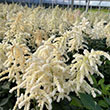
Soft, feathery, white flower heads bloom through the summer. Deer and rabbit resistant. USDA 4-9
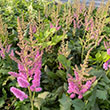
Pink blooms. Dwarf. Tolerates heavy shade, Wet sites & deer. USDA 4-8
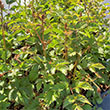
Purple to red blooms and dark green upright foliage. Perfers moist soil. USDA 4-8
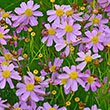
Height: 24 inches
Spread: 24 inches
Sunlight: full sun
Hardiness Zone: 4a
Description:
A beautiful variety with a long, continuous blooming season; dense, bushy mounds of ferny green foliage are covered in blush pink, daisy-like blooms from early summer to fall; excellent as groundcover, borders or in beds; deadhead to promote new blooms
Ornamental Features:
Pink Tickseed is smothered in stunning shell pink daisy flowers with yellow eyes at the ends of the stems from early summer to early fall. The flowers are excellent for cutting. Its ferny leaves remain green in color throughout the season.
Landscape Attributes:
Pink Tickseed is an open herbaceous perennial with a mounded form. It brings an extremely fine and delicate texture to the garden composition and should be used to full effect.
This plant will require occasional maintenance and upkeep, and is best cleaned up in early spring before it resumes active growth for the season. It is a good choice for attracting butterflies to your yard, but is not particularly attractive to deer who tend to leave it alone in favor of tastier treats. Gardeners should be aware of the following characteristic(s) that may warrant special consideration:
- Spreading
Pink Tickseed is recommended for the following landscape applications:
- Mass Planting
- General Garden Use
- Naturalizing And Woodland Gardens
Planting & Growing:
Pink Tickseed will grow to be about 24 inches tall at maturity, with a spread of 24 inches. Its foliage tends to remain dense right to the ground, not requiring facer plants in front. It grows at a medium rate, and under ideal conditions can be expected to live for approximately 10 years. As an herbaceous perennial, this plant will usually die back to the crown each winter, and will regrow from the base each spring. Be careful not to disturb the crown in late winter when it may not be readily seen!
This plant should only be grown in full sunlight. It does best in average to evenly moist conditions, but will not tolerate standing water. It is not particular as to soil type or pH. It is somewhat tolerant of urban pollution. This species is native to parts of North America. It can be propagated by division.
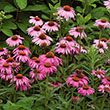
Fully double coral & raspberry blooms. Dark stems & foliage. USDA 4-9
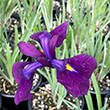
Purple blooms. Variegated foliage. Tolerates wet conditions. USDA 4-9
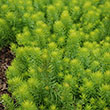
Height: 8 inches
Spacing: 10 inches
Sunlight: full sun, partial shade
Hardiness Zone: 2b
Other Names: Sedum reflexum
Ornamental Features:
Angelina Stonecrop is smothered in stunning yellow star-shaped flowers at the ends of the stems from early to mid summer. Its attractive succulent needle-like leaves remain gold in color throughout the season.
Landscape Attributes:
Angelina Stonecrop is a dense herbaceous perennial with a ground-hugging habit of growth. It brings an extremely fine and delicate texture to the garden composition and should be used to full effect.
This plant will require occasional maintenance and upkeep, and is best cleaned up in early spring before it resumes active growth for the season. Deer don't particularly care for this plant and will usually leave it alone in favor of tastier treats. Gardeners should be aware of the following characteristic(s) that may warrant special consideration:
-Spreading
Angelina Stonecrop is recommended for the following landscape applications:
- Mass Planting
- Rock/Alpine Gardens
- Border Edging
- General Garden Use
-Groundcover
Planting & Growing:
Angelina Stonecrop will grow to be about 8 inches tall at maturity, with a spread of 12 inches. When grown in masses or used as a bedding plant, individual plants should be spaced approximately 10 inches apart. Its foliage tends to remain low and dense right to the ground. It grows at a fast rate, and under ideal conditions can be expected to live for approximately 10 years. As an herbaceous perennial, this plant will usually die back to the crown each winter, and will regrow from the base each spring. Be careful not to disturb the crown in late winter when it may not be readily seen!
This plant does best in full sun to partial shade. It prefers dry to average moisture levels with very well-drained soil, and will often die in standing water. It is considered to be drought-tolerant, and thus makes an ideal choice for a low-water garden or xeriscape application. It is not particular as to soil pH, but grows best in poor soils, and is able to handle environmental salt. It is highly tolerant of urban pollution and will even thrive in inner city environments. This is a selected variety of a species not originally from North America. It can be propagated by division; however, as a cultivated variety, be aware that it may be subject to certain restrictions or prohibitions on propagation.
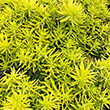
Height: 8 inches
Spacing: 10 inches
Sunlight: full sun, partial shade
Hardiness Zone: 2b
Other Names: Sedum reflexum
Ornamental Features:
Angelina Stonecrop is smothered in stunning yellow star-shaped flowers at the ends of the stems from early to mid summer. Its attractive succulent needle-like leaves remain gold in color throughout the season.
Landscape Attributes:
Angelina Stonecrop is a dense herbaceous perennial with a ground-hugging habit of growth. It brings an extremely fine and delicate texture to the garden composition and should be used to full effect.
This plant will require occasional maintenance and upkeep, and is best cleaned up in early spring before it resumes active growth for the season. Deer don't particularly care for this plant and will usually leave it alone in favor of tastier treats. Gardeners should be aware of the following characteristic(s) that may warrant special consideration:
-Spreading
Angelina Stonecrop is recommended for the following landscape applications:
- Mass Planting
- Rock/Alpine Gardens
- Border Edging
- General Garden Use
-Groundcover
Planting & Growing:
Angelina Stonecrop will grow to be about 8 inches tall at maturity, with a spread of 12 inches. When grown in masses or used as a bedding plant, individual plants should be spaced approximately 10 inches apart. Its foliage tends to remain low and dense right to the ground. It grows at a fast rate, and under ideal conditions can be expected to live for approximately 10 years. As an herbaceous perennial, this plant will usually die back to the crown each winter, and will regrow from the base each spring. Be careful not to disturb the crown in late winter when it may not be readily seen!
This plant does best in full sun to partial shade. It prefers dry to average moisture levels with very well-drained soil, and will often die in standing water. It is considered to be drought-tolerant, and thus makes an ideal choice for a low-water garden or xeriscape application. It is not particular as to soil pH, but grows best in poor soils, and is able to handle environmental salt. It is highly tolerant of urban pollution and will even thrive in inner city environments. This is a selected variety of a species not originally from North America. It can be propagated by division; however, as a cultivated variety, be aware that it may be subject to certain restrictions or prohibitions on propagation.

Ruffled petals with sunset pink and coral tones. Black walnut tolerant. USDA 3-9
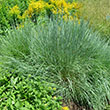
Upright clumps of slender, flat, linear bluish green leaves. Purplish-bronze blooms. Tolerates black walnut. USDA 3-9
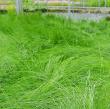
Height: 24 inches
Spread: 24 inches
Sunlight: full sun, partial shade
Hardiness Zone: 5b
Other Names: Stipa tenuissima, Needle Grass
Description:
An extremely delicate looking grass that provides gentle movement and sound in even the most delicate of breezes; a textural feast in the hands of a creative garden designer
Ornamental Features:
Mexican Feather Grass features airy plumes of gold flowers rising above the foliage in mid summer. Its attractive threadlike leaves are green in color. As an added bonus, the foliage turns a gorgeous harvest gold in the fall. The gold seed heads are carried on showy plumes displayed in abundance from late summer to late winter.
Landscape Attributes:
Mexican Feather Grass is a dense herbaceous perennial grass with an upright spreading habit of growth. It brings an extremely fine and delicate texture to the garden composition and should be used to full effect.
This is a relatively low maintenance plant, and is best cleaned up in early spring before it resumes active growth for the season. Gardeners should be aware of the following characteristic(s) that may warrant special consideration:
- Self-Seeding
Mexican Feather Grass is recommended for the following landscape applications:
- Mass Planting
- Rock/Alpine Gardens
- Border Edging
- General Garden Use
Planting & Growing:
Mexican Feather Grass will grow to be about 20 inches tall at maturity, with a spread of 24 inches. Its foliage tends to remain dense right to the ground, not requiring facer plants in front. It grows at a medium rate, and under ideal conditions can be expected to live for approximately 20 years. As an herbaceous perennial, this plant will usually die back to the crown each winter, and will regrow from the base each spring. Be careful not to disturb the crown in late winter when it may not be readily seen!
This plant does best in full sun to partial shade. It prefers dry to average moisture levels with very well-drained soil, and will often die in standing water. It is considered to be drought-tolerant, and thus makes an ideal choice for a low-water garden or xeriscape application. It is not particular as to soil type or pH. It is somewhat tolerant of urban pollution. This species is not originally from North America. It can be propagated by division.
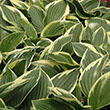
Dark green foliage framed in gold. Lavender blooms. USDA 3-9
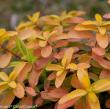
Bright yellow flowers bloom in spring to late summer, followed by attractive yellow to orange berries. Deer resistant. USDA 5-9
27 found, showing page 1 of 2













